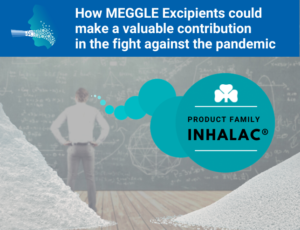Thoughts on COVID 19 – How can excipients support in the fight against Corona?
How MEGGLE Excipients could make a valuable contribution in the fight against the pandemic
SARS-CoV-2, a RNA-virus within the Corona family, has affected mankind all over the world and was therefore declared as pandemic (COVID 19). Since first appearance of this infection, global science and technology has reacted incredibly diverse and fast to stop, or at least slow down its spread. For the moment, classical vaccination strategies seem to be promising, however they might be challenged by the ability of the virus to mutate. In parallel, it is difficult to state long term safety of vaccines, and insufficient immune response of mainly senior populations draws the attention to local therapies: Respiratory system and in particular the nasopharyngeal zone were identified as entry and reservoir zone for SARS-CoV-2 and hence seem to be an highly appropriate target to intervene in the course of the disease (1).
Particle deposition has been applied very successfully for the delivery of anti-inflammatory and ß-sympathomimetic drugs in the fields of chronic lung diseases since more than two decades (2).
But it also can offer advantages over commonly applied aqueous spray pumps or dropping devices within an intranasal application, where significant amounts of an active principle are deposited in the anterior, less metabolically active region of the nasal cavity (3, 4). The application of dry powder formulations could e.g. allow antibiotics, immune modulators, or virostatics to reach more interior areas beyond the nasal valve and so leading to increased residence times, consecutively preventing the virus from its deadly seeding into the lungs by aspiration. In addition, solid state formulation systems are generally preferred from a chemical and microbiological stability point of view.
MEGGLE has a long tradition and broad subject expertise in the fields of drug delivery into the respiratory tract and can offer a wide range of approved solid carriers for nasal and pulmonary applications (InhaLac – product family).
- Hou YJ, Okuda K, Edwards CE, Martinez DR, Asakura T, Dinnon KH, Kato T, Lee RE, Yount BL, Mascenik TM, Chen G, Olivier KN, Ghio A, Tse LV, Leist SR, Gralinski LE, Schäfer A, Dang H, Gilmore R, Nakano S, Sun L, Fulcher ML, Livraghi-Butrico A, Nicely NI, Cameron M, Cameron C, Kelvin DJ, de Silva A, Margolis DM, Markmann A, Bartelt L, Zumwalt R, Martinez FJ, Salvatore SP, Borczuk A, Tata PR, Sontake V, Kimple A, Jaspers I, O’Neal WK, Randell SH, Boucher RC, Baric RS. SARS-CoV-2 Reverse Genetics Reveals a Variable Infection Gradient in the Respiratory Tract. 2020; Cell, 182:429-446 DOI: https://doi.org/10.1016/j.cell.2020.05.042
- de Boer AH, Hagedoorn P, Hoppentocht M, Buttini F, Grasmeijer F, Frijlink HW. Dry powder inhalation: past, present and future. 2017; Expert Opin Drug Deliv 14(4):499-512 DOI: https://doi.org/10.1080/17425247.2016.1224846
- Kimbell JS, Segal RA, Asgharian B, Wong BW, Schroeter JD, Southall JP, Dickens CJ, Brace G, Miller FJ. Characterization of deposition from nasal spray device susing a computational fluid dynamics model of the human nasal passages. J Aerosol Med. 2007; 20:59–74. [PubMed: 17388754]
- Frank DO, Kimbell JS, Pawar S, Rhee JS. Effects of Anatomy and Particle Size on Nasal Sprays and Nebulizers. Otolaryngology Head and Neck Surgery 2012:146 (2): 313-319 DOI: https://doi.org/10.1177/0194599811427519


